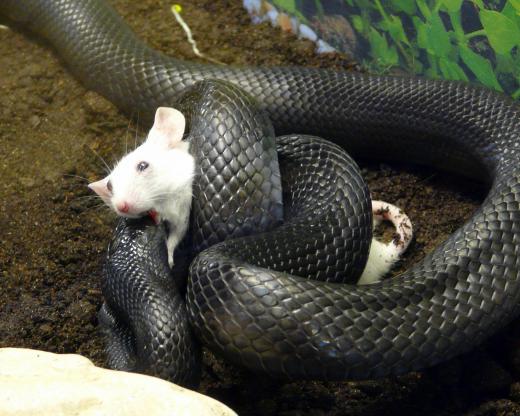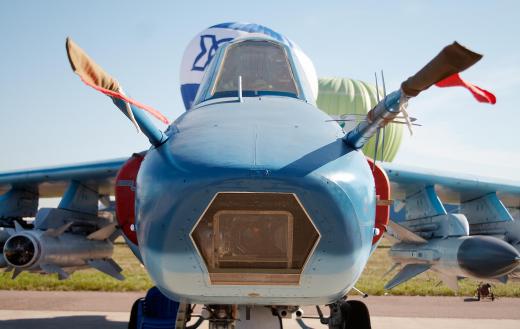What is Infrared Radiation?
 Diane Goettel
Diane Goettel
Infrared radiation, also known as “IR,” is just one type of radiation that exists within the electromagnetic spectrum. The radiation that is used in microwave ovens is a type of radiation that has a place on the electromagnetic spectrum, while the radiation that is used in hospitals to create X-ray images is another. The light rays that allow humans to see the world around them and the radio waves that are used to deliver news and music are also types of radiation that exist within the electromagnetic spectrum.
Infrared radiation is so named because the wavelength of infrared rays is just a bit longer than that of red rays. The only types of radiation that humans can detect are light rays. If humans could see infrared rays on the color spectrum, it would appear just after or below red. The Latin infra translates to “below”.

Infrared radiation is an incredibly important part of every human being’s life. This is because IR is quite literally heat. Although human eyes cannot visibly detect IR, they can surely feel it. Wrapping a hand around a cup of hot chocolate, take a walk in balmy weather, or enjoy sizzling fajitas; in all of these experiences are interacting directly with IR.

Although the human eye cannot detect radiation, scientists have developed mechanical eyes that can. IR cameras can take pictures of objects and beings that relay their topography in terms of the amount of heat that they are giving off. For example, in an IR photo of a snake eating a mouse, the cold blooded snake would be nearly invisible, but humans would be able to see the thermal outline of the warm blooded mouse.

There are many uses for infrared radiation cameras. They are used by the military to gain information about a target or place of interest. They are also used by astronomers to learn more about the cosmos. Meteorologists also use cameras that are sensitive to IR in order to predict temperatures and oncoming weather.
AS FEATURED ON:
AS FEATURED ON:













Discussion Comments
The IR signature can still be detected because the cool air does not inhibit the radiation. Assuming the second plastic cube was not opaque, then the IR would pass through mostly undisturbed.
In order to completely erase one's IR footprint one would have to have a "cube" that is conductive, as conductive materials impede radiation: something like copper foil, aluminum foil, mylar etc. However, this shielding would only prevent an IR camera from being able to discriminate objects that are obscured by the foil; it would not hide the fact that the foil is at a temperature warmer than normal(if in fact it is). A second layer of foil (spaced apart from the first) would need to be employed.
Eventually, the heat from the first cube would reach the second via convection and so an IR camera could potentially detect that the outer shield is at above average temperature. Circulating cool air between shields would prevent the outside shield from ever becoming warm enough to be detected.
The first shield will not re-radiate IR (such is supposed to be the case with mylar) but will still convect heat, which may still result in an IR footprint, depending on the setup.
So, one shield of foil is fine to conceal visual information but it will not prevent the shield itself from appearing warmer than it should, which for some people may be a concern. A second shield with cooling air running between the two shields is necessary to both conceal discriminating features and the actual temperature of the room.
Since the heat never convects (because it is cooled), neither convection nor (much)radiation makes it to the second sheet of mylar.
For those wanting to protect themselves from rogue IR camera fiends, the aforementioned setup is unrealistic but ideal.
How does infrared technology work? thank you.
@ Amphibious54- People might like to know how to prevent detection by IR sensing cameras in certain military situations as well. Insurgents in Iraq and Afghanistan have used some of the tactics I will list below to prevent IR detection.
Water is a good insulator; dispersing heat very quickly. In some environments, staying in or near water when IR cameras are suspected can help to avoid detection. In arid environments, lying prone and covering yourself with a wool blanket can mask your heat signature from planes or drones flying overhead since they will trap the heat given off by your body.
Light color clothes also reflect incoming IR so it can keep the subject cooler, requiring less to mask their IR signature. Mylar can also prevent a camera from picking up an IR signature, but beware the reflective nature of Mylar can give away your position just as easily.
@ Anon13625- Infrared radiation can be reflected by many materials. The earth's atmosphere is a good reflector of IR, and is what regulates the earth's surface temperature. This is why an overcast day is cooler than a sunny cay and an overcast night is warmer than a cloudless night. The clouds act as insulation, either preventing IR from penetrating to the surface or leaving into space.
One could apply this concept to other situations as well. Retaining IR can be the difference between survival and death in some situations. A person in a survival situation could use certain materials like Mylar and plastic sheets to reflect IR waves for warmth.
Creating pockets of air can also help to create a barrier to IR waves. For example, a clear plastic cube filled with hot air placed in a dark room would show up on an IR camera. If you were to enclose that plastic cube inside of another plastic cube with cool air, the camera probably would not pick up the IR signature.
what absorbs ir and what are the reflectors of it? thanx
Post your comments